Humans of New York: Art in Your Pocket
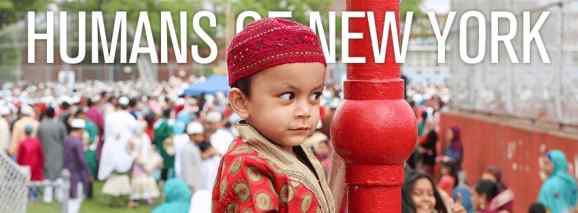
A wall-to-wall array of diverse-looking tiles overwhelms visitors to humansofnewyork.com. Such is the in-your-face nature of Brandon Stanton’s unique photographic project, Humans of New York (HONY). HONY seems to be everywhere, and you can’t escape it. He has recently returned from a ten-country world tour, in partnership with the United Nations, to raise awareness for the UN’s “Millenium Development Goals,” which include universal primary education, environmental sustainability, eradicating extreme poverty, and fighting disease. The HONY World Tour has put a new spotlight on Stanton and his project, and the comments that flood his Facebook page credit him with displaying the human side to people hitherto thought of only as “the poor” or “refugees.” The photographs from the tour highlight the problems of humans, people like us, as opposed to the problems of any region, country, or religion in particular.

Some of the stories are unimaginably heartbreaking; others are incredibly relatable.
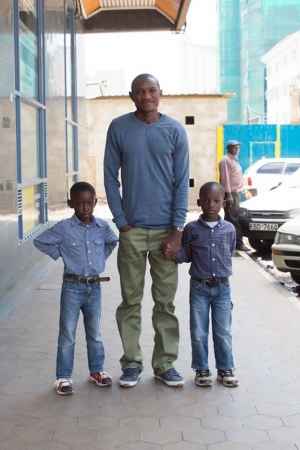
Humans of New York has really come a long way. It began in 2010, with the retrospectively limited goal of photographing 10,000 random New Yorkers. Stanton had a creative blog idea of displaying all the portraits on a map of New York, such that each neighborhood could be clicked on to reveal the people who live there—a mini photographic census. Nearly four years later, he has crossed the halfway mark. But much more significant is the growth of HONY from a mere project to a fulfilling journey. As he puts it himself, “HONY’s evolved so much. It used to be a photography blog. I can’t call it that any more. It’s a storytelling blog” (Harpaz).
Somewhere along the way, he gave up trying to choose or sort his subjects by area, and began wandering randomly until he found someone interesting. He follows-up the photo session with a quick interview, from which he picks out a point or two to include as a caption. His portraits became as much, if not more, about the captions than about the photos themselves.
A lot of the quality in my content comes from the caption. The most popular photos are, meh, average. I messed them up. But then afterwards I’ll be having a conversation with a person and they’ll give me a great line. A great quote can really carry a bad photo. (Groat)
He estimates that he walks 1 mile per subject, and averages 6 miles per day, passing 1000 people before taking a picture. It leaves one to wonder why. Why does Stanton choose to devote so much time to work that doesn’t pay? (Or at least it didn’t pay until last year, when he became a New York Times bestselling author with Humans of New York, the book, and Little Humans, which came out this month.)
Educated at the University of Georgia, Stanton moved to Chicago with a degree in history, and worked as a stockbroker. He was fired during the recession for, as he calls it, “taking too many risks.” Job gone, but risk-taking nature quite intact, he moved to New York with his camera, no formal technical training in photography, a month’s worth of living expenses, and not much else. In a situation wherein most people would scramble to try and get a secure job, Stanton did the exact opposite. Enacting any mother’s worst nighmare, he abandoned all caution and wandered the streets of an unknown city, talking to strangers. Now that people recognize him, his work is somewhat easier; but when he first began, getting potential subjects to agree was a difficult task.
There are lots of street portraits out there, but they’re filled with the young fashionable demographic. Those people never turn me down because those people all want to be photographed. Where it gets trickier is venturing into the demographics where people aren’t walking out the door expecting to be photographed. That’s what makes this photography difficult—dealing with the human element. Rejection just flows off me now (Groat).
A recent photo shows how far he has come since his early days. Taken in April of this year, it depicts a mother and her twenty-something daughter standing on a sidewalk, smiling ear to ear. The story of their encounter, as told by Stanton:
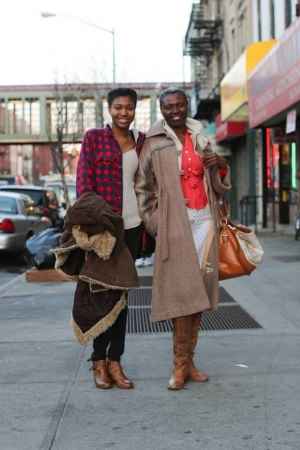
Stanton is a stout believer that achievement requires hard work and diligence. And diligent he is. In his own words, “With so many people competing for attention—everybody has a digital camera, everybody has a Tumblr account—you’ve got to be willing to do a lion’s share of the work before anybody notices you.” He says, when he started, he knew he really loved taking pictures, but didn’t really know where his ideas would take him (Groat). Occasionally selling prints of his portraits to get by, and sometimes even eating cat food, he continued doing something that no one who cared at all about him approved of. His risk-taking nature along with his disillusionment with his chosen career path, seems to have driven him down this new, unpaved road. Taking risks didn’t work in the financial market, but Stanton’s solution to that wasn’t to change himself. Instead, he changed his environment to one where anything goes. Taking risks is the only way forward in a direction no one has yet thought to take.
Even his work has a palpable sense of disorder. Portraits can pop up in my News Feed at anytime of day or night, and can feature any subject from anywhere in New York City. The disorganization mirrors the state of the city itself. There are some themes Stanton often returns to, like “Today in Microfashion,” featuring young children dressed uniquely or colorfully.

Photos of tattoos, unique hairstyles, and dancers in action are other mainstays.
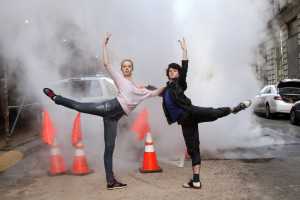
However, the photos with the most likes are often the unexpected ones. A memorable favorite is a picture he took while visiting Austin last year for SXSW (South by Southwest Music Conference and Festival). It depicts a rugged-looking middle-aged man relaxing on a chair in the night-time city lights, smoking a cigarette. His pink skin sets his multiple dark tattoos and yellow blonde hair in sharply contrasting focus.

Such an unexpectedly sweet end to a misleadingly unremarkable beginning strangely relates back to Stanton’s own struggles. His story began with a camera, ambition, uncertain end-goals, and a lack of technical skills, none of which set him apart from anyone else running a photoblog. But those things in combination, along with what he’s done with them over the years, have turned his story sweetly remarkable, and all the more so for its unanticipated trajectory.
With nearly 4 million followers on Facebook and Tumblr, and countless flattering spoofs like Humans of Paris, Humans of London, Humans of Los Angeles, and even Humans of NYU, Stanton’s efforts are finally paying off; and more so than he had ever imagined. He has been covered by various publications and news programs ranging from The Wall Street Journal and The Village Voice to CBS News and New York 1.
As with any artist, not all the attention is positive though. He has been accused of painting too rosy a picture of New York by focusing heavily on little kids and pets, as opposed to the true, grittier inhabitants of the city. Outer borough residents criticize him for spending too much time in Manhattan, making outer borough residents such as myself feel ignored. His own fans rightly called him out for insensitivity when he captioned a photo of a young boy learning baseball with a ball so big he couldn’t miss, “pansy.” He later apologized, and pulled down that particular photo. But if bad publicity is impossible to avoid as an artist, Stanton has done a great job of minimizing it. Perhaps it is the unconventional nature of his presentation that leaves less room overall for negative criticism. His art goes straight to his audience; they can pull it up on their PC while at work, it pops up in their newsfeed as they scroll through social media, and most of his fans have the not-so-secret desire of being “chosen” to be a part of his art. This is what ultimately sets him apart. His art is his audience, and his audience is his art.
He speaks cautiously about not wanting to be “jaded,” about reflecting on whether he is now less sensitive to the ordinary moment as a possibly interesting subject, than he was when he first started (Groat). It reminds me of the trajectory of most Facebookers; at first any moment seems worthy of sharing as a status, but we gradually become more selective about what might be interesting enough to post. Stanton actively tries not to change his standards for what makes a great portrait. But this certainly doesn’t mean he hasn’t grown or improved over the years. And he isn’t unaware of such changes either. “Before, I was visually responding to the street. I wasn’t looking for anything in particular. Now I look for someone sitting alone. I look for people who are approachable” (Harpaz). And not everyone is thrilled about being approached. One of his photos features the back of one such man in the W 4th Street subway station:
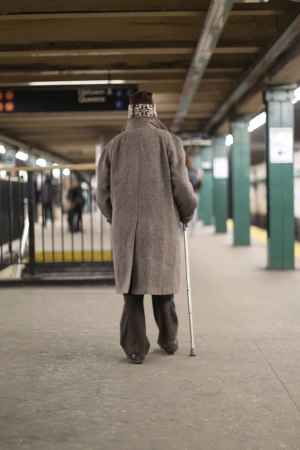
When he started out, Stanton wasn’t even asking for permission from his subjects. It’s something he might possibly get away with now, but back when he was still unknown, he was even threatened and cursed at for his actions (Stanton, A Chat). Now that he always asks first, Stanton makes his subjects subconsciously aware of the camera, and even when they don’t deliberately pose, he can’t get the same shot that initially caught his eye and made him walk over. Thus, part of the evolution of HONY is a loss of candidness. While somewhat regrettable, I see it as a necessary sacrifice for the sake of expanding a local art project to global proportions.
He has become so popular in a fairly short time span, and he certainly hasn’t escaped the notice of various companies looking to cash in on the latest phenomenon. In 2013, DKNY offered to purchase 300 of Stanton’s photos for $15,000 to use in marketing campaigns. An industry friend advised him that $50 per photo wasn’t nearly enough from a company with hundreds of millions of dollars of revenue. So he asked for more money. They turned him down. A few months later, a fan in Bangkok discovered DKNY using Stanton’s photos in their window display. Stanton immediately took to his home turf to protest. On his Facebook page, he called out DKNY for the unfairness, and asked them to donate $100,000 to the Bedford-Stuyvesant YMCA for having used his work without his permission. He asked his followers and fans to reblog his request to drive the point home to DKNY. The company eventually claimed an honest mistake, and donated $25,000 (Stanton, humansofnewyork.com). This one example shows the potential Stanton has to have a palpable impact on our society. He has a direct reach to his audience, which coupled with his use of social media and far-reaching success, makes Stanton fairly unique. His art is not only popular among his fans, but it also catches the eye of average folks who stumble upon his photos when their Facebook friends like them. Pretty soon, the friends-of-followers become followers themselves.
And this was much before the life-changing world tour. The tour, with the peaceful mission of bringing to light some fundamental problems, succeeded in putting a human face on what we in the west tend to distantly think of as statistics. The portraits of people around the world showed us to feel empathy for the human beings who are suffering, regardless of who should be blamed for the conflicts they find themselves caught in.

Stanton’s forte is elevation of regular people to portrait-worthy subjects of art. This is what defines his reach and appeal, which are uniquely his own. Even when photographing extraordinary subjects like the above monk, Stanton subtly brings out their “regular guy” side. His reach and appeal in turn define his place in New York art and culture, and in the world. Through his art, he has provided New Yorkers with a sense of community; anyone who walks down a street becomes part of this community that is Stanton’s canvas. HONY—the art on that canvas—is somewhat of a staple among New Yorkers. If they see an approaching muscular, six-foot-four-inch man dressed casually in a T-shirt and cargo pants, wearing his baseball cap backward, carrying a camera and a hopeful smile, they aren’t alarmed. Quite the contrary, it’s like meeting a celebrity.
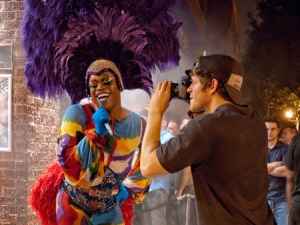
Like the mother and daughter who couldn’t believe their luck, his subjects relish the opportunity to speak to him. Perhaps sometimes, it’s even like meeting an old friend after a long time. Like the gentleman in Austin, they tell him their stories. They share with him their most personal moments, even allowing him to show them to the world. Even people in refugee camps and remote villages, who aren’t familiar with his work open up to him. To me this speaks volumes about how much these people trust Stanton, trust that he will present their sensitive feelings in the most positive way, and trust that other New Yorkers will understand their story. The community of his canvas is also a community of trust. Stanton was able to win this personal trust through his art, gradually, over the course of building his body of work. Notably, he was able to do it in a city infamous for being impersonal. And to think, none of it would have been if someone hadn’t thought to fire a risk-taker.
Works Cited
Groat, Jon. “Video Profile: Photographing the ‘Humans of New York’.” 1 August 2012. New York Magazine. Article. 30 March 2014.
Harpaz, Beth J. “Popular Humans of New York Photoblog Now a Book.” 11 October 2013. Associated Press. Article. 28 March 2014.
Stanton, Brandon. humansofnewyork.com. New York, 25 February 2014. Blog.
Stanton, Brandon. “Brandon Stanton: A Chat with a Human Photographer in New York Chris Gampat.” Explora B&H, 2013. Interview.
What do you think? Leave a comment.










HONY absolutely rocks.
New York has to be the best place on the planet for street photography, as evidenced by the voluminous body of work that has historically emerged. Anyone prepared to spend “two hours every day … wandering the streets” cannot fail to produce work like this, awash as it is with photogenic weirdos. The real skill comes in giving depth – the occasional accompaniment of textual context goes some way; forgoing the whimsicality would go further.
That said, the work is commercially successful and, ultimately, isn’t that what it’s all about.
Lovely. The UK version of this is the brilliant Crossing Paths, by Niall McDiarmid.
Yet more pointless snaps of narcissistic bourgeois hipsters.
Errr, you haven’t checked out his work, have you? The photography isn’t anything great–Stanton’s a serviceable photographer– the best thing is, as he says himself, the stories that come along with the photos. He emphatically doesn’t just shoot self-important posers; a lot of the people he stops have remarkable stories that one would never guess from their outer appearance. His gift is in, while showing us quite simply what they look like, getting them to reveal the often poignant and touching stories beneath.
Stanton doesn’t let art get in the way of the soul, and that’s exactly right for a project like this.
I check out HONY every day- it’s the only reason I’m still on Facebook- and Brandon takes pictures of people from all walks of life.
A fantastic body of work which shows the warmth, compassion and humanity of the people of New York. The blog and facebook page have stories and often humble experiences of the everyday person, and there is a connection of a shared emotion – this I believe is what makes HONY so successful.
I have never heard of HONY before reading this. Very excited to check it out. Thanks for writing about it.
I’ve looked at HONY before, and after a few times, I decided to stop looking at them because I felt like they always featured people of color with sad/devastating stories, and only the white people got happy, smiling captions.
This guy is a big damn hero. Far more so than any soldier is. People like him, the world needs more of! It’s about time we all rise above hate!
Absolutely wonderful project he’s got going on!
I’ve been watching his progress daily for weeks. The photographs are beautiful, the stories are enlightening, heartbreaking, and humbling.
The images are nice but really pretty pedestrian – same half dozen poses repeated ad infinitum. The subjects are great though, and show a great cross-section of the people of New York (quite clearly not just the hipsters if you look at the HONY site).
Meantime, if you want to check out some really cool New York street shots go find JustinDisgustin on Flickr – yes, NY Hipsters, but such good photos..
One of the greatest things about HONY is that it gets others to empathise with people that they might never normally encounter in real life. I think HONY forces people to confront any biases they might have about a certain group of people and force them to see everyones humanity. Unfortunately most people will not talk to the homeless man in the subway station, the elderly lady with the pretty hat, the man carrying flowers for his girlfriend. HONY reveals the humanity in everyone, and hopefully people who follow HONY will bring this empathy and humanity to other areas of their lives.
Brilliant. I have never been to NYC – want to very much – in fact, I’d say that after looking at these photographs I now long to…
I am glad that I chose this article to write my very first comment on at The Artifice. Certainly HONY is a phenomenon worth noting. Amena Banu tells so rightly why that is the case in this article. I am particularly intrigued by the following lines that allude to the oneness of things:
“His art is his audience, and his audience is his art.” “The community of his canvas is also a community of trust.”
Amena, thank you for this article. The selection of photographs make me feel closer to New York! The first photo is so great I appreciate you sharing this information.
I enjoyed your article. I am always hesitant of projects like this because they are an artists view of New York and its people. My New York looks very different. I’m sure the project resonates differently depending on if you have lived there or not.
HONY is unique in that it re-awakens are awareness of humanity: both the good and the bad.
Wow. I can’t even take my previous comment seriously because I wrote “are” instead of “our”. There goes my faith in my own humanity…
It’s okay, we all make mistakes 🙂
Very excited to know about HONY. New York City is an attractive place to visit.
It is fantastic!
I get so touched by all these amazing little quotes those people tell him. It’s inspiring.
The images are beautiful and counter every portrayal mainstream media brainwashes as the reality of those areas.
He is in his own right fucking brilliant! As a fellow photographer: Respect!
HONY is amazing. Brandon is amazing.
I love HONY, one of my favorite pieces he wrote was about the chess player and his philosophy on life. There was just something very raw about it and sincere that makes the rest of his work feel even more honest.
And it’s wonderful! Makes reality of these places. Such terrible things the people have survived. Let me know about a place helping traumatised kids heal that I can donate to regularly.
HONY is doing great things for the American mainstream
The HoNY guy is amazing, he has shown a lot of people that humans are humans. You’d think that would be obvious, but in today’s hate-soaked and toxic corporate media it’s easy to see other people, especially people in other countries, as sinister clumps of otherness.
HONY is my one of the best Instagram accounts to follow. When he went abroad this year it got even better and I hope he travels like that again soon.
Very impressive to see what amazing things happen when you leave your comfort zone and enter the unknown. Inspiring in a artistic and professional sense.
Great article! I love the work that Brandon Stanton is doing. It is so easy to default to just seeing people as statistics. It’s nice to have something like “HONY” to help one remember to see the individual.
HONY is indeed a wonderful thing. It brings the world closer to people who otherwise would not encounter a certain type of person or situation. Plus it’s just plain cool to see so many different people and hear what they have to say.
Also, this reminds me of a definition from the Dictionary of Obscure Sorrows: Sonder n. the realization that each random passerby is living a life as vivid and complex as your own—populated with their own ambitions, friends, routines, worries and inherited craziness—an epic story that continues invisibly around you like an anthill sprawling deep underground, with elaborate passageways to thousands of other lives that you’ll never know existed, in which you might appear only once, as an extra sipping coffee in the background, as a blur of traffic passing on the highway, as a lighted window at dusk. http://www.dictionaryofobscuresorrows.com/post/23536922667/sonder
What I love about HONY is that sometimes we forget that every city’s population is made up of individual people and not just a mass of faces. This series captures bits of other’s lives and serves as a reminder that, although no two lives are alike, and every stranger has a story.
It’s fascinating to get the background on HONY and how it became the humongous thing that it is now. I have such an appreciation for Stanton and what he does.
Great article. I love how you showed how he became successful.
This was an exceptional piece of writing! The HONY blog has always been fascinating, and it has been incredible to watch it evolve from a purely photographic blog to something with a mission and deep meaning. It brings notice to those that society, for the most part, has gone out of it’s way to avoid. Fantastic article.
I’m a huge fan of Brandon’s, and I think what he’s doing is extremely inspirational. I attend a private university in a midwestern town and one of my peers has made a Humans Of page for our campus and the town and it’s a big hit – what I love the most about the Humans Of experience is how it forces you to connect with others. It brings complete strangers together, and removes part of the “What if?” factor that we all sort of feel when we pass people on the street.
I love reading Humans of New York everyday. The short little views into peoples lives remind me that not everyone has the same experiences and viewpoints just because they exist in the same place.
Here in the Humans of New York Project we have an experiment that exploits the full potential of the Internet. It is easy to feel that in our modern day world of technological wonders that people are throwing away the power of the Internet, losing it to Instagram, tumblr, etc. However, Stanton has done something which provides an overwhelmingly positive, if not terribly skillful, artistic message to millions of people. This form of storytelling is something that can only possible with the Internet and shows just how incredible the inventions of our modern world can be.
The thing that I love most about HONY is its ability to bring people together – which you cover very well in this article. I love looking through the comments on his pictures because of the amount of positive feedback from his audience which is hard to find anywhere else on the internet. It’s amazing that he has helped build a sense of community between the people he photographs as well as between the people who see the pictures and read the stories.
I agree with the previous comment, but my favorite part about HONY is the untold stories being told. For instance, nobody would publicize these amazing stories if it weren’t for organizations like this. As a screenwriter, I am constantly on the hunt for unrecognized heroes and tales of humanity, which helps me identify greatly with this work. Let the people know!
Never heard of HONY before. I really enjoyed while reading. Thanks
Wow, I had no idea that Hony had spread so far, and included so many people! Great article!
I love HONY for the simple fact that it forces us to acknowledge the universal experiences/feelings that tie us all together. We so often get stuck in this idea of separation – that our experiences are singular and unique to ourselves and NOBODY else could possibly understand. These stories featured on HONY remind us that we are not alone.
I am a new HONY fan thanks to some friends of mine showing me the Facebook and Instagram accounts. I have to say, the pictures and the stories that go up everyday are quite inspiring. There are many that make me sad, many that give me joy, some that I can relate to, and others that I empathize for. I enjoy the rawness and truth to the photos, the people, and the stories.
Great look at a great project. I love the simpler posts where the beauty is in the photo, but the backstories given are also really interesting and diverse.
What is somewhat problematic about HONY is the idea that, on some level, the project opens up certain kinds of subjects to a level of spectation that, thanks to the unpredictable nature of internet popularity, may lead to rhetorical or ideological violence against those depicted. Cindy Cruz, above, makes a good point about the distribution of agony: on balance, people of color are attached to stories of trauma, white people to stories of joy. The storytelling here, is the problematic element – while the photos themselves create possibilities for meaning that could be said to be neutral, attaching linguistic content to the photographs has an outsize influence on our interpretations.
Love your last sentence, how it attributes being fired as the best thing that ever happened to him. My favorite thing about HONY is how relatable we can be to faces that we would never guess that we had something in common with. There aren’t many stereotypical captions in his work.
For me, the best thing about HONY is the way Brandon is able to get these people to tell him their stories. Yes, they add to the photos and make some of them more memorable. But getting someone to open up about their biggest, happiest, or saddest life experiences after just a few minutes of talking is just amazing to me. It allows people to look at the HONY page and see a whole new level of diversity and depth in people that they would otherwise never get to see.
I wonder if HONY might soon be changed to HOTW: Humans of The World? Brandon seems to be able to transcend even the most blockaded social and cultural barriers in a unique and individual way that is acharacteristic for most people. This piece really captures that.
His sense of joy and perseverance is inspiring! A side note- while the photographs are certainly important, I find the quotes from his subjects to be even more revealing. It seems to be the intriguing and inspiring words in the photo captions that most often prompt re-postings and “likes” on Facebook. I’d be curious to learn more about his interview process… funny that it gets so little attention in the shadow of his photography.
I have never read about Stanton’s feelings or how HONY was started. I really enjoyed learning about that. Stanton’s work is inspiring and truthful, honest, raw. Working in NY, I always hope to be stopped by him one day 🙂
Stanton’s photographs make my day, every day.
I love HONY and the power with which it conveys stories. The stories make you laugh out loud and cry, and speak to a human sentiment that is universal and joyous. It’s amazing to think how much power a man with a camera and Internet has accumulated in the last few years. On one hand, there’s all this technology which actually enables him to be do this job, and on the other hand, we have this raw human emotion, which is what he’s selling. By all means, I think that HONY is a paradox. But what a beautiful paradox it is…
I love the paradox that is HONY. On one hand, there is the incredible power this man has simply because of his camera and access to the Internet. On the other hand, his art is the display of raw, human emotions.
Since writing this, he has also done a lot in regards to raising money for different community projects in New York. I find it really interesting that his platform has worked for charities in a way that appeals to people in a personal yet distant way. I think people gravitate to this type of charity because it isn’t confrontational and abrupt.
I enjoy reading each face and imagined their life stories. The first time I knew about HONY was through the book few years ago. My 6-grader daughter that time was amazed by the diversity of people. I always think New York is the city that reflect the authenticity of human beings. Everyone is a race and so unique..there is no one who is not beautiful…
Fun article.